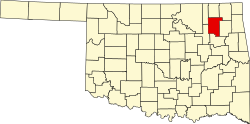Rogers County, Oklahoma | |
|---|---|
 | |
 Location within the U.S. state of Oklahoma | |
 Oklahoma's location within the U.S. | |
| Coordinates: 36°18′38.35″N95°37′1.48″W / 36.3106528°N 95.6170778°W | |
| Country | |
| State | |
| Founded | January 26, 1907 |
| Named after | Clement Vann Rogers |
| Seat | Claremore |
| Largest city | Claremore |
| Other cities | Catoosa, Collinsville, Owasso, Tulsa |
| Government | |
| • Chairman | Steve Hendrix |
| Area | |
• Total | 711 sq mi (1,840 km2) |
| • Land | 676 sq mi (1,750 km2) |
| • Water | 36 sq mi (93 km2) 5.0% |
| Population | |
• Total | 95,240 |
| 101,371 | |
| • Density | 141/sq mi (54.4/km2) |
| Time zone | UTC−6 (Central) |
| • Summer (DST) | UTC−5 (CDT) |
| ZIP Codes | 74015, 74016, 74017, 74018, 74019, 74031, 74036, 74053, 74080 |
| Area code | 539, 918 |
| Congressional districts | 1st, 2nd |
| Website | www |
Rogers County is a county located in the northeastern part of the U.S. state of Oklahoma. As of the 2020 census, the population was 95,240, [1] making it the sixth-most populous county in Oklahoma. The county seat is Claremore. [3] Rogers County is included in the Tulsa metropolitan area.
Contents
- History
- Geography
- Adjacent counties
- Demographics
- 2021 estimates
- 2020 census
- 2010 census
- Politics
- Communities
- Cities
- Towns
- Census-designated places
- Unincorporated communities
- Education
- NRHP sites
- References
- External links
Created in 1907 from the western Saline District of the Cherokee Nation, this area was named the Cooweescoowee District, and Cooweescoowee County at the time of statehood. However, the residents protested, and the name was changed to Rogers County, after Clem Vann Rogers, a prominent Cherokee rancher, and father of Will Rogers. [4] [5]





